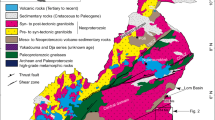Abstract.
Porphyry copper-gold, skarn copper-gold, sediment-hosted (Carlin-style) gold, breccia pipe, low-sulphidation epithermal gold, pluton-related (mesothermal or orogenic) gold vein and volcanogenic massive sulphide deposits associated with alkaline rocks are commonly broadly similar to those hosted by their calc-alkaline counterparts. In contrast, porphyry molybdenum-gold deposits are confined to alkaline igneous centres. Alkaline suites are notably deficient in high-sulphidation epithermal gold deposits and even in the advanced argillic lithocaps which host them. This is surprising, given that the required oxidised sulphur species are seemingly more abundant than in calc-alkaline igneous centres. Highly efficient buffering of acidic fluid by metasomatised alkaline rocks may offer a viable explanation. All types of intrusion-related zinc deposits also appear to be poorly developed in alkaline provinces. The characteristics of several gold and copper deposits associated with alkaline rocks, including the giant Porgera, Cripple Creek, Ladolam, Olympic Dam and Phalaborwa examples, are judged to diverge appreciably from their most closely related deposit types, rendering them arguably unique. Most of these aberrant mineralisation styles may be due to variations in magmatic-fluid compositional and liberation characteristics consequent upon the extreme diversity of ore-related alkaline magmas. Most types of gold and copper deposits developed in calc-alkaline provinces also constitute exploration targets in and around alkaline igneous centres, although porphyry copper-gold and low-sulphidation epithermal gold deposits are considered to possess the greatest potential. Perhaps of even greater interest, however, is the possibility of encountering unconventional giant gold and copper deposits which lack closely analogous examples. If already-defined aberrant deposits are truly unique, then exploration designed specifically to detect additional examples is pointless. Furthermore, exploration for new unique deposits is difficult because their defining geological parameters are unknown. Alkaline rocks within or behind calc-alkaline arcs at convergent plate boundaries probably offer the greatest exploration potential, although anorogenic intracontinental extensional settings should not be ignored.
Similar content being viewed by others
Author information
Authors and Affiliations
Additional information
Electronic Publication
Rights and permissions
About this article
Cite this article
Sillitoe, R.H. Some metallogenic features of gold and copper deposits related to alkaline rocks and consequences for exploration. Min Dep 37, 4–13 (2002). https://doi.org/10.1007/s00126-001-0227-6
Received:
Accepted:
Issue Date:
DOI: https://doi.org/10.1007/s00126-001-0227-6




